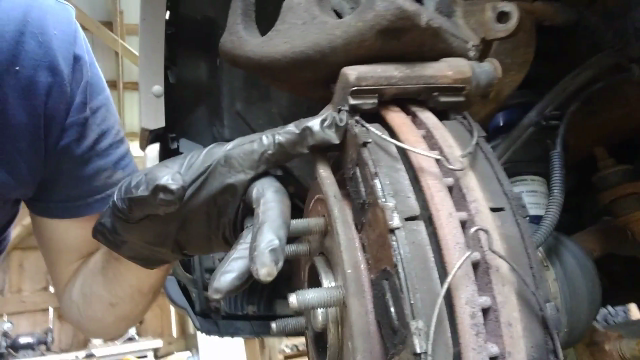To be personally free we need to work toward self-reliance and build resilience around the systems that enable our way of life.
While explaining the basic operation of brakes and how to maintain them, I’ll draw a correlation to being mindful of the many systems in our life and to be aware of the early signs of problems so that we can address them before they become catastrophic.
The Basic Principle
The brake pedal is connected to a piston in a master cylinder.
When you push your brake pedal, that piston is pushing fluid through the brake lines to each brake.
At each brake is a slave cylinder, called a caliper, which exerts pressure on a pad which will rub on a rotor.
When you release the brake pedal the pressure in that system should drop and the pads should come off the disc. If they don’t, you have a problem.
Indications of a problem
Like most problems it’s best to solve this one sooner than later. Uncorrected, this could leave you on the side of the road with a blazing hot brake disc. Here’s what to look for:
- Dragging – this is most clear as you leave a stop sign. When you take your foot off the brake the car doesn’t start to creep forward.
- Heat – After driving several miles, if you can feel the heat coming off a wheel by placing the back of your hand near the wheel, then there’s a problem. It’s best to check all four to calibrate your heat sensor.
- Smell – This is how I know it’s getting bad, when I can smell that burning smell as I’m unpacking my truck. That smell should clue you in to do the heat test in number 2.
- Dirty Wheel – If the pads are always riding on the rotor, brake dust will build up on the wheel. Sometimes you can tell just by looking at the wheel that there is a problem.
Causes of the problem
In my experience, there are two main causes for the disc to stay pushed up against the rotor:
- Stuck disc
- Stuck caliper
The discs ride in a little channel and it’s common for that channel to fill with debris that restrict the disc causing it to get stuck.
The caliper is an enclosed piston that can also wear out over time and get stuck.
Solving the Problem
The first thing I do is try the free fix by inspecting the discs and, if they’re in question, clean them up and apply some fresh grease.

Brake discs ride in a channel that can collect debris causing the discs to get stuck. If the wheel is getting hot, and the discs move freely, then the caliper is probably stuck.
If I take the brakes apart and the discs are moving all nice and free, then it’s time to replace the caliper.
For my 2005 F-150 the rear caliper cost $50 and the front cost $70 after the core charge. That means I get about $20 back per caliper when I bring them back to the store in the original box with receipt.
How to Replace the Caliper
Here are some straightforward instructions for replacing a brake caliper. I recommend you go to YouTube and search the year, make, and model of your vehicle to get the best instructions.
- Raise and support the vehicle
- Remove the wheel
- Compress the caliper with a C-clamp
- Remove the old one
- Install the new one
- Bleed the brake lines
- Put it all back together
What This Article is Actually About
One of my objectives is to provide you, my reader and audience, the motivation and courage to perform maintenance on your vehicle.
Like everything in life, and everything I teach, all aspects of our life are connected like a gigantic, complex spiderweb.
When you begin doing the maintenance on your car, you get way more in tune to how your car is performing. I like to brag that I built my first car, a 1977 Jeep CJ-7, that I bought for $150 and brought home on my dad’s flatbed trailer. I drove that Jeep on and off road for years and it never broke down on me except for ONE time! When it did, though, I had the part sitting on the back seat and the tools to install it in the center console.
The point is, when you know and understand the systems of your vehicle (and anything else) you can, almost subconsciously, recognize changes in the system and detect problems before they become severe.
There isn’t a more simple way to explain this than with the brakes on your car.
And if you ignore these indications of a problem?
They get worse.
Just. Like. Everything. Else.
Marriage. The job. Kids. The furnace. Life.
In almost all circumstances a problem will be catastrophic only after it has displayed early signs.
The best way to recognize those early signs is to be engaged and to understand how systems work.
The Kicker
I’ve drawn a correlation between a brake job and a marriage. I stand by it, but do so knowing that I’m a little more engaged in observing systems than most. So, let’s peel back into the practical a little bit.
Did you catch that the new calipers cost $50 and $70?
Dude. Have you ever rolled out of a shop for $50? I expect that I never will.
Ok, so you can save a few bucks. But what about TIME?
“I don’t have the time to work on my car.”
Well, it took about an hour to install the new caliper. I would need to take several hours out of my day and coordinate a ride (taking someone else’s time) or sit in a shop pretending to work if I had someone else do it.
I save TIME and MONEY by working on my own car!
At the risk of going a little deep on you again, I also remain proficient in using tools and solving problems. I get re-engaged on mechanical systems and I inspect all the other components in the vicinity of the one I’m working on, which is another troubleshooting technique.
For Example! While I was working on my brakes I noticed my pinion seal is leaking on my rear differential. Stay tuned on this, because there is a good chance I WILL use a shop for this job, and it will be good for you to see why.
The First Bolt is the Hardest
Like everything else, the hardest part is to start.
If you do build the courage to do some work for yourself, do your research in the vehicle manual and on YouTube and make sure you have all the tools and parts necessary. Spend the extra time on research to improve your success and build your confidence to try the next job.
Please let me know when you do. I recognize the pride that comes with what others call simple successes. If you’ve never changed your oil, and you go forth with courage and get it done, I’m there to cheer you on. I get it.
Lastly, this deserves more attention, but ask around and find someone to serve as a mentor as you embrace the work. Maybe you can use their shop and tap into their experience, or maybe they’ll just answer the phone when you call. Either way, this is huge, again, in more ways than one.



